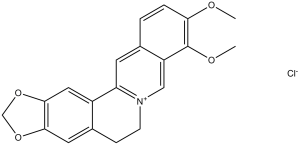Berberine HCl
This product is for research use only, not for human use. We do not sell to patients.

For small sizes, please check our retail website as below: www.invivochem.com
| Size | Price | Stock |
|---|---|---|
| 5g | $160 | Check With Us |
| 10g | $280 | Check With Us |
| 20g | $420 | Check With Us |
Cat #: V1980 CAS #: 633-65-8 Purity ≥ 98%
Description: Berberine HCl (Natural Yellow 18 chloride), an isoqinoline alkaloid extracted from the Chinese herbal medicine Huanglian, is a quaternary ammonium salt from the group of isoquinoline alkaloids with varoius biological activities.
Top Publications Citing Invivochem Products
Publications Citing InvivoChem Products
Product Promise

- Physicochemical and Storage Information
- Protocol
- Related Biological Data
- Stock Solution Preparation
- Quality Control Documentation
| Molecular Weight (MW) | 371.81 |
|---|---|
| Molecular Formula | C20H18ClNO4 |
| CAS No. | 633-65-8 |
| Storage | -20℃ for 3 years in powder formrr |
| -80℃ for 2 years in solvent | |
| Solubility In Vitro | DMSO: > 10 mMrr |
| Water: NArr | |
| Ethanol: NA | |
| Synonyms | Natural Yellow 18; Berberinium chloride; BBR; Umbellatine |
| Protocol | In Vitro | Berberine (1.25-160 μM; 72 hours) has potential inhibitory effects on the proliferation of four colorectal carcinoma cell lines LoVo, HCT116, SW480, and HT-29 |
|---|---|---|
| In Vivo | Berberine (10, 30, or 50 mg/kg/day; gastrointestinal gavage; for 10 consecutive days) inhibits the growth of human colorectal adenocarcinoma in vivo. Berberine at doses of 30 and 50 mg/kg/day taken by gastrointestinal gavage shows inhibitory rates of 33.1% and 45.3% on the human colorectal adenocarcinoma xenograft growth in nude mice | |
| Animal model | 5-week-old BALB/c nu/nu mice with human colorectal adenocarcinoma LoVo xenografts | |
| Dosages | 10, 30, or 50 mg/kg/day | |
| Administration | Gastrointestinal gavage; for 10 consecutive days |
These protocols are for reference only. InvivoChem does not
independently validate these methods.
| Solvent volume to be added | Mass (the weight of a compound) | |||
|---|---|---|---|---|
| Mother liquor concentration | 1mg | 5mg | 10mg | 20mg |
| 1mM | 2.6895 mL | 13.4477 mL | 26.8955 mL | 53.7909 mL |
| 5mM | 0.5379 mL | 2.6895 mL | 5.3791 mL | 10.7582 mL |
| 10mM | 0.2690 mL | 1.3448 mL | 2.6895 mL | 5.3791 mL |
| 20mM | 0.1345 mL | 0.6724 mL | 1.3448 mL | 2.6895 mL |
The molarity calculator equation
Mass(g) = Concentration(mol/L) × Volume(L) × Molecular Weight(g/mol)
Mass
=
Concentration
×
Volume
×
Molecular Weight*
The dilution calculator equation
Concentration(start)
×
Volume(start)
=
Concentration(final)
×
Volume(final)
This equation is commonly abbreviated as: C1 V1 = C2 V2
Concentration(start)
C1
×
Volume(start)
V1
=
Concentration(final)
C2
×
Volume(final)
V2
Step One: Enter information below
Dosage mg/kg
Average weight of animals g
Dosing volume per animal µL
Number of animals
Step Two: Enter the in vivo formulation
%DMSO
+
%
+
%Tween 80
+
%ddH2O
Calculation Results:
Working concentration:
mg/ml;
Method for preparing DMSO master liquid:
mg
drug pre-dissolved in
µL
DMSO(Master liquid concentration
mg/mL)
,Please contact us first if the concentration exceeds the DMSO solubility of the batch of drug.
Method for preparing in vivo formulation:
Take
µL
DMSO master liquid, next add
µL
PEG300, mix and clarify, next add
µL
Tween 80,mix and clarify, next add
µL
ddH2O,mix and clarify.
Note:
- (1) Please be sure that the solution is clear before the addition of next solvent. Dissolution methods like vortex, ultrasound or warming and heat may be used to aid dissolving.
- (2) Be sure to add the solvent(s) in order.




































